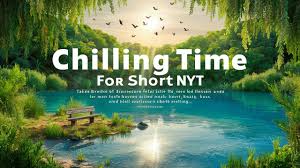Introduction
Ever find yourself scrolling through the New York Times (NYT) and noticing an increasing number of articles about relaxation, downtime, and the importance of taking a break? You’re not alone. This concept, often dubbed “Chilling Time,” is gaining traction as more people seek balance in their hectic lives. But what exactly is “Chilling Time For Short Nyt,” and why is it resonating so strongly with readers? In this article, we’ll dive deep into the trend, explore its origins, and discuss its impact on modern society.
What is “Chilling Time”?
Definition and Meaning
“Chilling Time” is more than just a casual phrase; it represents a growing movement towards prioritizing relaxation and downtime in our daily lives. It’s about deliberately setting aside time to unwind through leisurely activities or simply doing nothing at all.
How It Originated
The “Chilling Time” concept isn’t new, but its modern interpretation has evolved significantly. While people have always sought moments of peace, the fast-paced nature of contemporary life has made these moments more elusive. As society increasingly values productivity, “Chilling Time” has emerged as a counterbalance, encouraging individuals to slow down and enjoy life’s simpler pleasures.
The Impact of Chilling Time on Modern Life
In today’s world, where busyness is often worn as a badge of honor, “Chilling Time” challenges this notion by advocating for balance. The rise of this trend reflects a collective yearning for a more relaxed and fulfilling life, where success isn’t solely measured by productivity but also by one’s well-being.
The Popularity of “Chilling Time” in NYT
The Role of Media in Popularizing Chilling Time
The New York Times, a leading voice in modern journalism, has significantly brought “killing Time” to the forefront. Through articles, opinion pieces, and lifestyle features, NYT has highlighted the importance of relaxation, influencing how its readers perceive and prioritize their downtime.

The Evolution of the Trend in NYT
Initially, “Chilling Time” might have appeared as a niche topic, but over time, it has evolved into a mainstream conversation. NYT has chronicled this shift, providing a platform for thought leaders, psychologists, and everyday people to share their insights and experiences with downtime.
Why Readers Are Drawn to Chilling Time Content
Why is this content so appealing? For many, “Chilling Time” resonates because it addresses a fundamental human need – the need to rest. In a world that often feels overwhelming, the idea of dedicating time to relaxation is not just attractive; it’s necessary.
How “Chilling Time” is Interpreted Across Different Cultures
The Global Perspective
While “Chilling Time” has gained significant attention in the U.S., it’s essential to recognize how this concept is interpreted globally. Different cultures have their versions of relaxation, each bringing a unique perspective to what it means to chill.
Cultural Differences in the Concept of Relaxation
In Japan, for instance, “Chilling Time” might be seen through the practice of “Ikigai,” where finding joy in every day routines is central. In Scandinavian countries, the concept of “hygge” emphasizes coziness and contentment. These cultural variations highlight that while the desire to relax is universal, the methods can vary greatly.
Examples from Various Countries
Take the siesta in Spain, a time-honored tradition of taking a midday break. In Italy, the “passeggiata” is a leisurely evening stroll that embodies relaxation. Each of these practices reflects the importance of incorporating downtime into daily life, a testament to the global relevance of “Chilling Time.”

The Psychological Benefits of “Chilling Time”
Stress Reduction
One of the most significant benefits of “Chilling Time” is its ability to reduce stress. Taking time to unwind can lower cortisol levels, the hormone associated with stress, leading to a calmer mind and body.
Enhancing Creativity
Interestingly, downtime isn’t just about relaxation; it’s also a powerful tool for boosting creativity. When we step away from work and allow our minds to wander, we often find that new ideas and solutions come to us more easily.
Improving Mental Health
Regularly incorporating “Chilling Time” into your routine can also improve your overall mental health. It provides a much-needed break from the pressures of daily life, helping to prevent burnout and maintain emotional balance.
Chilling Time and Its Connection to Lifestyle Choices
Minimalism and Chilling Time
The minimalist lifestyle, which emphasizes simplicity and reducing clutter, naturally aligns with the concept of “Chilling Time.” Both encourage living intentionally and focusing on what truly matters, whether that’s relationships, personal growth, or simply enjoying the moment.
The Slow Living Movement
Similarly, the slow living movement, which advocates for a more deliberate and mindful approach to life, complements “Chilling Time.” Both trends push back against the notion that faster is better, promoting instead the value of taking one’s time.
How Technology Influences Our Downtime
However, it’s essential to consider how technology influences our ability to relax. While apps and gadgets can offer tools for mindfulness and relaxation, they can also be a source of distraction. Finding the right balance is key to making the most of your “Chilling Time.”
Chilling Time in the Digital Age
The Role of Social Media
Social media plays a double-edged role in “Chilling Time.” On one hand, it can be a platform for sharing relaxation tips and connecting with like-minded individuals. On the other hand, it can contribute to anxiety and stress if not managed carefully.
Apps and Gadgets for Chilling
There are countless apps designed to help you relax, from guided meditation sessions to ambient noise generators. Gadgets like smart lighting and aromatherapy diffusers can also enhance your “Chilling Time,” creating a serene environment that’s conducive to relaxation.
Balancing Screen Time with Real Relaxation
But while these digital tools can be helpful, they shouldn’t replace genuine downtime. It’s important to strike a balance, ensuring that your “Chilling Time” includes moments away from screens, allowing you to fully disconnect and recharge.

The Economic Impact of Chilling Time
How the Market Adapts to the Trend
The rise of “Chilling Time” has also had an economic impact, with the market quickly adapting to meet the growing demand for relaxation-related products and services.
The Rise of Chilling-Related Products
From luxurious bath products to cozy loungewear, the market for items that enhance relaxation is booming. Consumers are increasingly willing to invest in products that help them unwind, reflecting a broader shift in priorities.
Impact on the Hospitality and Leisure Industries
The hospitality and leisure industries have also felt the effects of this trend. Wellness retreats, spa vacations, and even hotels focused on relaxation are becoming more popular as people seek out ways to incorporate “Chilling Time” into their travel plans.
How to Incorporate “Chilling Time” into Your Daily Routine
Practical Tips for Relaxation
Incorporating “Chilling Time” into your daily routine doesn’t have to be complicated. Start with small changes, like setting aside a few minutes each day for deep breathing or enjoying a cup of tea without distractions.
Setting Boundaries
One of the most effective ways to ensure you have “Chilling Time” is by setting boundaries. This might mean turning off your phone during certain hours or saying no to commitments that don’t align with your need for downtime.
Mindfulness and Meditation Practices
Mindfulness and meditation are powerful practices that can enhance your “Chilling Time.” Even just a few minutes of meditation each day can help you stay grounded and make the most of your relaxation moments.
Common Misconceptions About “Chilling Time”
Busting the Myths
Despite its growing popularity, there are still some misconceptions about “Chilling Time.” One common myth is that it’s synonymous with laziness, but in reality, it’s about self-care and maintaining balance.
Chilling Time is Not Just About Doing Nothing
Another misconception is that “Chilling Time” means doing absolutely nothing. While rest is certainly a part of it, “Chilling Time” can also involve engaging in activities that bring you joy and help you unwind.

It’s Not a Waste of Time
Lastly, some people believe that taking time to relax is a waste of time. However, as we’ve explored, “Chilling Time” can improve productivity, creativity, and overall well-being.
Case Studies and Real-Life Examples
How Successful People Chill
Even some of the world’s most successful individuals prioritize “Chilling Time.” For instance, many entrepreneurs and CEOs incorporate meditation, exercise, or hobbies into their routines to help them relax and recharge.
Personal Stories from NYT Readers
NYT readers have also shared their experiences with “Chilling Time.” From busy parents finding moments of peace to professionals carving out time for self-care, these stories highlight the diverse ways people are embracing downtime.
Lessons Learned from Different Approaches
These real-life examples offer valuable lessons in how to make “Chilling Time” work for you, no matter your lifestyle or schedule.
Challenges in Embracing “Chilling Time”
The Modern Hustle Culture
One of the biggest challenges in embracing “Chilling Time” is overcoming the pressure of hustle culture. In a society that often equates busyness with success, taking time to relax can sometimes feel counterintuitive.
Overcoming Guilt in Relaxation
Many people also struggle with feelings of guilt when they take time to relax. However, it’s important to remember that “Chilling Time” is essential for maintaining balance and preventing burnout.
Finding the Right Balance
Finding the right balance between work and relaxation can be tricky, but it’s crucial for your overall well-being. By prioritizing “Chilling Time,” you can create a more sustainable and fulfilling lifestyle.
The Future of “Chilling Time”
Predicting the Evolution of the Trend
As the popularity of “Chilling Time” continues to grow, we’ll likely see even more emphasis on relaxation and downtime in the coming years. This trend may evolve in response to changing societal needs, but its core message will remain the same: balance is key.
The Role of AI and Automation in Freeing Up Time
AI and automation could also play a role in the future of “Chilling Time.” By taking over mundane tasks, these technologies could free up more time for relaxation, allowing people to focus on what truly matters.

Will Chilling Time Become the New Normal?
Ultimately, the question remains: will “Chilling Time” become the new normal? As more people recognize the importance of balance, this trend may become a permanent fixture in our lives.
Conclusion
In a world that’s constantly on the go, “Chilling Time For Short Nyt” offers a much-needed reminder to slow down and enjoy the moment. By incorporating relaxation into our daily routines, we can improve our well-being, boost our creativity, and lead more fulfilling lives. So why not give it a try? Your mind and body will thank you.
FAQs
What Does “Chilling Time” Mean?
“Chilling Time” refers to setting aside time to relax and unwind, either through leisurely activities or simply doing nothing.
How Can I Start Incorporating Chilling Time?
Start small by setting aside a few minutes each day for activities that help you relax, like deep breathing, meditation, or enjoying a quiet moment with a cup of tea.
Is Chilling Time Suitable for Everyone?
Yes, “Chilling Time” can be beneficial for everyone, regardless of lifestyle or schedule. It’s all about finding what works best for you.
How Has NYT Contributed to This Trend?
The New York Times has popularized “Chilling Time” through various articles, opinion pieces, and lifestyle features, helping to bring the concept to a wider audience.
What Are the Best Activities for Chilling Time?
The best activities for “Chilling Time” are those that help you relax and recharge, such as reading, meditating, taking a walk, or simply enjoying a quiet moment.










